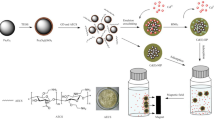Abstract
A new chitosan imprinting adsorbent using diatomite as core material was prepared by using the surface molecular imprinting technology with the Pb2+ as imprinted ion. The preparation process conditions of the surface molecular imprinting adsorbent were studied. The adsorbent was characterized by using Fourier transform infrared (FTIR) spectrum. FTIR spectrum indicated that it was cross-linked by epichlorohydrin. The new imprinting adsorbent could provide a higher adsorption capacity for Pb2+, which reached 139.6 mg/g increasing 32.3% compared with cross-linking chitosan adsorbent (the initial Pb2+ concentration of 600 mg/L). The adsorption velocity was quick and the equilibration time of the imprinting adsorbent for Pb2+ was 3 h that shortened about 40% compared with cross-linking chitosan adsorbent. It had a more wide pH range of 5–7 than that of cross-linking chitosan adsorbent. The new imprinting adsorbent can be reused for up to ten cycles without loss of adsorption capacity. In the kinetics and isotherm study, the pseudosecond order model and Langmuir model could represent the adsorption process.









Similar content being viewed by others
References
Al-Degs, Y., Khraisheh, M. A. M., & Tutunji, M. F. (2001). Water Research, 35, 3724–3728. doi:10.1016/S0043-1354(01)00071-9.
Jin, L., & Bai, R. (2002). Langmuir, 18, 9765–9770. doi:10.1021/la025917l.
Ying, X., & Fang, Z. (2006). Journal of Hazardous Materials, 137, 1636–1642. doi:10.1016/j.jhazmat.2006.04.055.
Entezari, M. H., & Bastami, T. R. (2006). Journal of Hazardous Materials, 137, 959–964. doi:10.1016/j.jhazmat.2006.03.019.
Wan Ngah, W. S., Endud, C. S., & Mayanar, R. (2002). Reactive & Functional Polymers, 50, 181–190. doi:10.1016/S1381-5148(01)00113-4.
Huang, C., Chung, Y. C., & Liou, M. R. (1996). Journal of Hazardous Materials, 45, 265–277. doi:10.1016/0304-3894(95)00096-8.
Liu, X. D., Tokura, S., Haruki, M., Nishi, N., & Sakairi, N. (2002). Carbohydrate Polymers, 49, 103–108. doi:10.1016/S0144-8617(01)00308-3.
Chu, K. H. (2002). Journal of Hazardous Materials, 90, 77–95. doi:10.1016/S0304-3894(01)00332-6.
Al-Ghouti, M. A., Khraisheh, M. A. M., & Tutuji, M. (2004). Chemical Engineering Journal, 104, 83–91. doi:10.1016/j.cej.2004.07.010.
Al-Degs, Y., Khrasisheh, M. A. M., & Tutunji, M. F. (2001). Water Research, 35, 3724–3728.
Wulff, G. (1995). Angewandte Chemie. International Edition in English, 34, 1812–1832. doi:10.1002/anie.199518121.
Vallano, P. T., & Remcho, V. T. (2000). Journal of Chromatography. A, 887, 125–135. doi:10.1016/S0021-9673(99)01199-1.
Ye, L., Ramstrom, O., & Mosbach, K. (1998). Analytical Chemistry, 70, 2789–2795. doi:10.1021/ac980069d.
Haijia, S., Sa, C., & Tianwei, T. (2007). Process Biochemistry, 42, 612–619. doi:10.1016/j.procbio.2006.11.013.
Haijia, S., Zhixing, W., & Tianwei, T. (2005). Journal of Chemical Technology and Biotechnology (Oxford, Oxfordshire), 80, 439–444. doi:10.1002/jctb.1206.
Li, Q., Su, H., Li, J., & Tan, T. (2007). Journal of Environmental Management, 85, 900–907. doi:10.1016/j.jenvman.2006.10.023.
Haijia, S., Ying, Z., Jia, L., & Tianwei, T. (2006). Process Biochemistry, 41, 1422–1426.
Li, N., & Bai, R. (2005). Industrial & Engineering Chemistry Research, 44, 6692–6700. doi:10.1021/ie050145k.
Ho, Y. S., & McKay, G. (1999). Water Research, 33, 578–584. doi:10.1016/S0043-1354(98)00207-3.
Acknowledgements
The authors want to express their thanks for the supports from Natural Science Foundation of China (20636010 and 50373003), the National Basic Research Program (973 Program) of China (2007CB714305), and the (863) High Technology Project (2006AA020101).
Author information
Authors and Affiliations
Corresponding author
Appendix
Appendix
- c 0 :
-
the initial concentration of metal ion (mg/L)
- η :
-
the removal rate
- Q :
-
the quality of the adsorbed Pb for per gram adsorbent (mg/g)
- c e :
-
the equilibrated concentrations of metal ion (mg/L),
- V :
-
the volume of added solution (L)
- W :
-
the weight of the adsorbent (g)
- t :
-
the adsorption time (min)
- q :
-
the adsorptive capacity of time (mg/g)
- q e :
-
the balance adsorption capacity (mg/g)
- k 2 :
-
the second-level adsorption velocity constant [g/(mg min)]
- q m :
-
the maximum adsorption capacity (mg/g)
- b :
-
constant
Rights and permissions
About this article
Cite this article
Jiang, W., Su, H., Huo, H. et al. Synthesis and Properties of Surface Molecular Imprinting Adsorbent for Removal of Pb2+ . Appl Biochem Biotechnol 160, 467–476 (2010). https://doi.org/10.1007/s12010-008-8366-1
Received:
Accepted:
Published:
Issue Date:
DOI: https://doi.org/10.1007/s12010-008-8366-1




